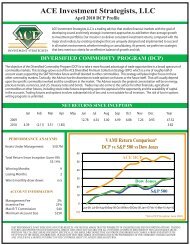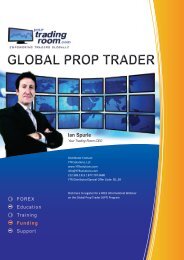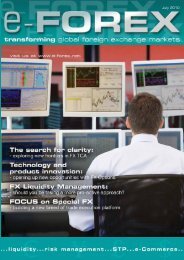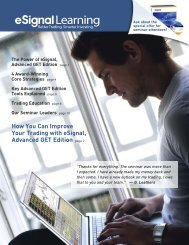Create successful ePaper yourself
Turn your PDF publications into a flip-book with our unique Google optimized e-Paper software.
FEATURES >>><br />
providing as much forewarning as possible of<br />
potential bottlenecks. “Another way we have been<br />
addressing these choke points in the STP model is by<br />
using standard protocols, such as FIX and FpML, as<br />
much as possible, both in the interaction with third<br />
parties and trading locations and within the<br />
application, to process the flow of transactions.”<br />
Gosling says that the endgame is to be able to process<br />
increased volumes with no increase in processing cost,<br />
or in an ideal world, to reduce these costs. Therefore the<br />
focus is on removing cost from the lifecycle of over the<br />
counter instruments and typically a lot of the cost still<br />
resides in the middle and back office. “Firms are looking<br />
to cope with known growth, and the scalability to cope<br />
with unpredicted future growth, and equate that back<br />
to cost per trade calculations so there is a clear case to<br />
management for return on investment,” he says.<br />
Improvements to STP<br />
Paul Hodgson, product manager, Front Arena SunGard,<br />
says that big improvements have been made in the use<br />
of the single confirmation of trades between customer<br />
and bank for the more vanilla derivatives enabling<br />
traders to negotiate more exotic trades individually.<br />
However, he adds, the most significant improvements in<br />
relation to STP efficiency has been in the front-end<br />
systems, as these ensure consistency of data from the<br />
point of negation by getting data entry from the<br />
customer/counterparty. Hodgson says this is the single<br />
most effective tool in the reduction of 'fails' and the<br />
improvement in STP rates.<br />
“Many technological advances have helped here.<br />
However they have not <strong>com</strong>pletely alleviated the<br />
situation, there are still many <strong>com</strong>ponents of the pricing<br />
process which involve data that is protected or restricted<br />
in its distribution to the broader market. Particularly in<br />
relation to OTC derivatives where the more <strong>com</strong>plex<br />
models may need data derived from very sophisticated<br />
analyses in what many consider proprietary systems that<br />
are their ‘market edge’,” he says.<br />
Hodgson believes that ‘choke-points' will always exist<br />
in any trading environment but as long as the number<br />
of variables used in the trade increase gradually, and<br />
systems provide an STP framework whilst also allowing<br />
new instruments to be rapidly exposed to the end<br />
investor, it will ease the processes from its initiation.<br />
However, he says that as increased volumes drive<br />
down spreads, and make it more viable for more<br />
dynamic hedging of derivative trades for traders and<br />
62 | january 2010 e-FOREX<br />
Paul Hodgson<br />
“The pressure to reduce costs is only sustainable if<br />
organisations can rely on processing solutions that deliver in<br />
a consistent and scalable way implementing STP and<br />
exception-based processing concepts.”<br />
investors alike, the systems supporting the activity<br />
have to improve STP to reduce the cost per ticket to<br />
ensure that increased overall transaction fees do not<br />
consume savings in the market spreads.<br />
Processing solutions<br />
Hodgson says: “The pressure to reduce costs is only<br />
sustainable if organisations can rely on processing<br />
solutions that deliver in a consistent and scalable way<br />
implementing STP and exception-based processing<br />
concepts.”<br />
Paul Moffat, operations product manager, Front Arena<br />
SunGard adds that the key to this is to ensure that the<br />
modelling of vanilla, and new, more structured products,<br />
follows a paradigm that allows for powerful extensibility,<br />
without ‘breaking’ existing processes or products.<br />
He says: “In the processing area, technology is key to<br />
ensuring that the <strong>com</strong>plex models mentioned above<br />
can be ‘broken down’ into their processing <strong>com</strong>ponents<br />
– settlement, confirmation, and accounting – for both<br />
the original transaction, and the ongoing lifecycle<br />
events that will occur. Systems that deliver processes<br />
that can handle these events in a generic way will<br />
deliver significant cost savings and risk reductions.”










